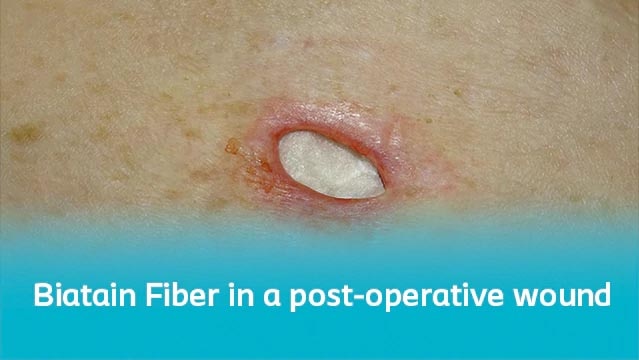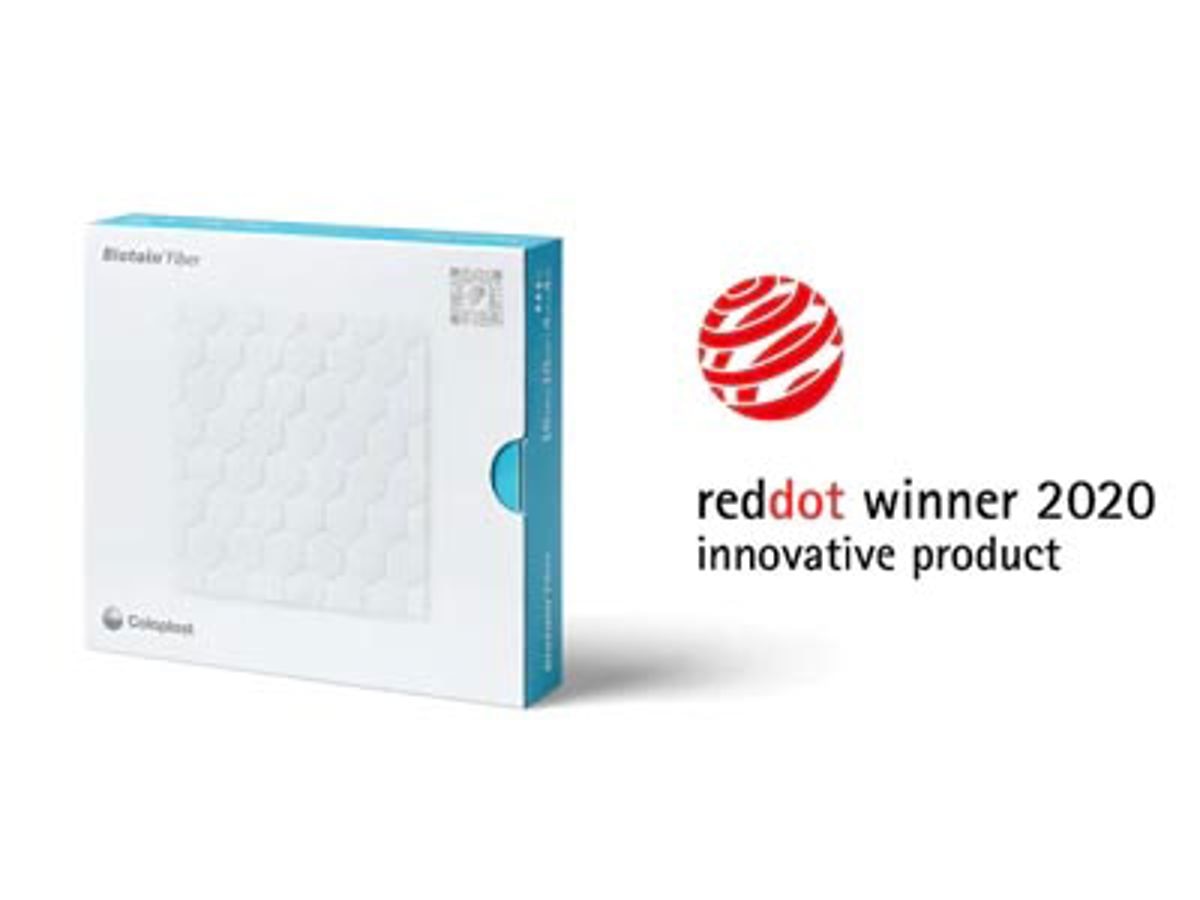
Watch the video to see how Biatain® Fiber is easily applied and removed in a 38mm deep post-operative abdominal wound.
Biatain® Fiber with HexaLock® Technology is a gelling fiber for all highly exuding, sloughy and cavity wounds, including undermining.
It effectively absorbs and retains exudate and bacteria, thereby reducing exudate pooling. It also keeps in shape, minimising risk of gap creation and further exudate pooling.
Biatain® Fiber is indicated for use in acute and chronic wounds such as diabetic ulcers, leg ulcers (arterial ulcers, venous ulcers and leg ulcers of mixed aetiology), pressure ulcers (stage II-IV), exudate absorption in oncology wounds, traumatic wounds, partial-thickness burns, donor sites, and post-operative surgical wounds.
BiCo fibers are welded together with CMC gelling fibers for extra strength.
The fibers are locked together by thermobonding.
The fiber dressing is reinforced with a unique hexagon net by ultrasonic embossment that locks the fibers together.
The HexaLock® Technology locks in exudate and bacteria, minimises shrinkage and forms a cohesive gel for one-piece removal

The Red Dot "Product Design” category awards date back to 1955 - appraising the best products created every year. Biatain Fiber received recognition for its outstanding product design as the winner of the Red Dot “Product Design 2020: Innovative Product” award.
Biatain® Fiber was awarded in this new product design category because of its innovative product components. Red Dot describes the award winners of the “Innovative Products” category as products that set new standards and lay the foundation for fundamental industry change.
Pooling of wound exudate can occur when exudate is not managed effectively or when the wound bed is not covered by an absorbent dressing, leading to an increased risk of bacterial growth and infection. Unmanaged exudate can also leak onto the wound edges and the periwound skin, which may cause maceration and delay wound healing.
| Size (cm) | Qty | Code | NHS | PIP |
|---|---|---|---|---|
| 5 x 5 | 10 | 33501 | ELY865 | 416-3374 |
| 10 x 10 | 10 | 33503 | ELY868 | 416-3366 |
| 15 x 15 | 10 | 33506 | ELY868 | 416-3382 |
| 2.5 x 46 | 10 | 33508 | ELY867 | 416-3382 |
Biatain Fiber is indicated for use in:

Watch the video to see how Biatain® Fiber is easily applied and removed in a 38mm deep post-operative abdominal wound.

Both variants of Biatain® Fiber make the application and change easy for all highly exuding, sloughy and cavity wounds, including undermining.
A gelling fiber must be able to lock in exudate effectively to support the wound healing and reduce the risk of exudate pooling, maceration and infection. The dressing must also keep the exudate locked in, even when used under compression.
Testing Biatain Fiber’s locking capacity in laboratory tests
To investigate a gelling fiber’s locking efficiency, you can test the absorption and retention capacity under pressure. In this test, a square variant of Biatain Fiber measuring 10 x 10 cm and weighing 2.2 grams was used. The dressing was placed in a demo tool dish where it absorbed 22 ml of liquid, equivalent to 10 times its own weight.
Absorption under pressure
The dressing was cut to match the shape of the silica filter. Both the dressing and filter were placed under a weight corresponding to 40 mm Hg, which is the common pressure used in a compression dressing.
Biatain Fiber with HexaLock Technology proved to retain the absorbed fluid perfectly, demonstrating the ability to lock in exudate effectively even under compression.
Easy one-piece removal is vital in deep and exuding wounds to ensure the procedure consumes as little time as possible. It also allows the wound healing process to be undisturbed by any residues from the dressing.
The strength of Biatain Fiber with HexaLock Technology has been demonstrated after absorption of test fluid. Here a pre-cut Biatain Fiber could withstand a tension of 500 grams when wet, promoting easy removal with minimal risk of leaving any residues in the wound.
Besides effective control of exudate, a fiber dressing can also play an important role in supporting autolytic debridement. This depends on the dressing’s ability to absorb and retain slough with a higher viscosity than normal exudate.
Lock in slough
Biatain Fiber with HexaLock Technology has been tested in vitro to determine if it can lock in slough in the same way it locks in exudate with normal viscosity.
In the test, a stable camera recording shows Biatain Fiber absorbing a thick blue liquid with the same viscosity as slough. While it takes slightly longer than normal exudate, it is just as effective in absorbing and retaining slough
Two versions
Biatain Fiber comes in two versions: a square variant in different sizes and a ribbon variant. Both variants can be handled in the same way.
How to open the package
Open the package with the text side facing upwards and along the turquoise line. Take the dressing out of the package using sterile gloves or sterilized tweezers.
Highly exuding wounds
Choose the size of Biatain Fiber that will cover the wound bed and edges. Cut to fit if necessary. In highly exuding and sloughy wounds, place Biatain Fiber in the wound and gently press to ensure close contact. The dressing will then conform to the wound bed and the wound edges.
Wounds with undermining
You can use the square or ribbon dressing variants for cavity wounds that include undermining. Gently fill the undermining without forcing the dressing tightly in. Apply more Biatain Fiber as needed to cover the wound bed. Make sure there are no gaps between the dressing and the wound bed. Press Biatain Fiber gently into place so that it conforms to the wound bed, as well as the wound edges.
Cover with a secondary dressing
Cover with a secondary dressing such as Biatain Silicone or compression dressing, depending on the wound condition and local practice
Up to 7 days wear time
Biatain Fiber can be left in the wound for up to seven days or until it has reached its maximum absorption capacity. When it is time for changing Biatain Fiber, start by removing the secondary dressing. Biatain Fiber can then be easily removed in one-piece thanks to the cohesive gel, with minimal risk of leaving residues in the wound. Easy one-piece removal ensures reduced discomfort and pain for your patients.
Biatain Fiber with HexaLock Technology